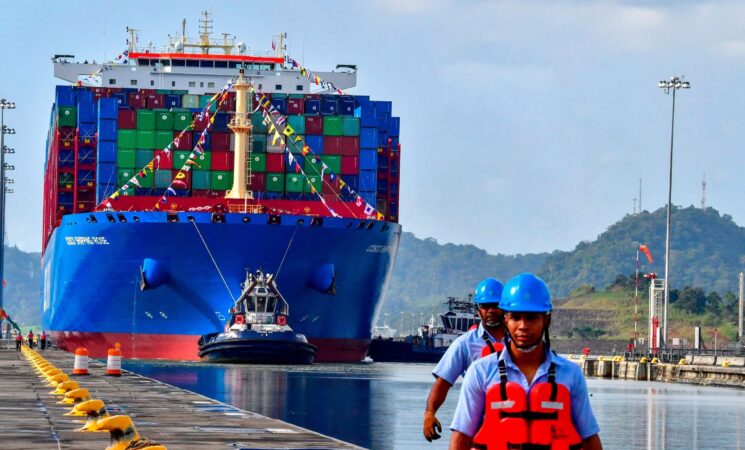26 March 2025, NIICE Commentary 10030
Dr Chander Shekhar
Panama Canal’s recent elevation in global geopolitics amidst China’s inscrutable rise in international trade and counter-globalization wave pushed strategic pundits to contemplate its role captured in recent years as strategic waterways in the Caribbean. Maritime chokepoints provide a strategic shipping route for international trade and commerce. In global shipping, its relevance cannot be neglected, which has never been a historic, strategic, and geopolitical burden that could disturb the supply chain and affect national economies. There are many narrow passes that are considered a backbone of this industry, such as the Strait of Malacca, Suez Canal, Strait of Hormuz, Panama Canal, etc. Each has its own geopolitical relevance in the freedom of trade and maritime security. Among others, the Panama Canal, mistreated over many decades, gained global recognition after Trump 2.0’s historic pledge to regain and correct past mistakes amidst China’s grown influence, a preventive policy intervention to reshape shipping and maritime security in the region.
Reclaiming the Canal by the United States with Strength
The Panama Canal, which became functional in 1914, plays a crucial role in transiting ships and contributing to international trade. It reduces time and distance by creating an 82km long artificial waterways connecting the Atlantic to the Pacific Ocean. It accounts for around 3% of international trade in volume, with a 46% share in containers originating mainly from Northeast Asia. In the US’s trade volume, approx. 40% of all US container traffic traverses the Canal each year facilitating the movement of roughly $270 billion in cargo. That makes geopolitically relevant in the current changing balance of power and liberal international order.
Analyst(1993) notes that before the First World War till 1992, the trade volume from the Panama Canal had witnessed a historic transformation. Before WWI and until the end of WWII, including the great depression period the trade transit volume remained low however, post-WWII economic miracles of Japan, South Korea, and Taiwan led the Canal mushroom by soaring up the cargo from 29 million tons in 1950 to 159 million tons in 1992. According to the Lloyd report (2025), as the US is planning an “invasion of Panama”, geopolitical tensions are set to increase in the region, even after the sale of ports by Hong Kong-based companies to BlackRock and Swiss billionaires.
On March 4, Trump stated that “to further enhance our national security, will be reclaiming the Panama Canal and we’re taking it back”. The Federal Maritime Commission reaffirmed the statement emphasizing that “the Canal holds substantial geopolitical importance, crucial to the US interest, any political instability or disruptions in its operations could have wider consequences”.
However, the control of the Panama Canal also received criticism and resistance as investors were spooked. The role of the United States in building the Canal cannot be overlooked, in the words of Trump, around 38,000 people lost their lives while building the Panama Canal. Barring Panama-flagged ships could place significant geopolitical pressure on Panama as it registers over 8,000 vessels and Panama could lose huge revenue out of it and open doors for other countries such as the Marshall Islands for reflagging.
The Canal faces several challenges in the dry season due to the decrease in water flow and it often creates difficulty to transit ships through it. Sources suggest that as of March 2024 when the water level made it difficult to pass ships, the Panama Canal Authority imposed restrictions on the number of ships that could be passed through, which delayed and increased shipping costs and, as a result, saw a 36% decline in ship crossings. In the mid-year every year, things become normal for sailing ships.
The disruption, as the UNCTAD report tells, causes huge supply-side challenges, increasing the costs, and reshaping global trade patterns with vulnerable economies hit hardest. To deal with these challenges coordination and cooperation between countries are required and strengthen diversified options by investing in resilient infrastructure.
Potential Decline of China in the Shipping Route
With its economic rise, China’s opening and pragmatic policies have pushed it to make relations across countries and expand its trade. Panama and the People’s Republic of China established their diplomatic relations in 2017 and earlier had maintained relations with the government of Taipei. China is engaged in various infrastructure projects in Panama such as the railway, building of a container port, etc.
In 1999, the Panama Canal was handed over to the Panama government under the agreement signed in 1977 by then-President Jimmy Carter. The concern for the US is China controlling the Canal. In his January 20, 2025, Inaugural address, the President said “China is operating the Panama Canal, we didn’t give it to China, we have it to Panama, and we’re taking it back”.
India’s Leverages
India’s relations with the United States under Trump 2.0 and Panama are good. Moreover, India’s ties with Panama date back to the 19th century and the 20th century when Indians were brought there to construct railways and the Panama Canal. By establishing their diplomatic relations in 1962, both are committed to enhancing their close cultural, political, and economic, as well as business relations. As Panama is a country that relies on the service sector and tourism hub, while on the other hand, Indian companies can collaborate with Panama and increase its ties by helping Panama to grow in trade and development.
In 2022-23, the total trade volume between the two was recorded at more than USD 597.91 million India has long adopted a policy called pro mundi beneficio (for the benefit of the world) to make relations with all countries cordial and peaceful for development and peace.
Conclusion
The Panama Canal has emerged as a new center of strategic cooperation and competition, with the US’s potential to take over, undo previous mistakes, and China’s withdrawal from the region, especially port construction and another connectivity project. To protect its economic, strategic, and national security interests, the US would take over by force and protect its strategic trade chokepoints. With China’s decline, India has a cordial relationship with Panama, which can take leverage by engaging in projects that give stimulus to Panama’s growth and development, including in the shipping sector and reflagging opportunities.
Dr Chander Shekhar was associated with the Research Information System for the Developing Countries and the Indian Council of World Affairs, New Delhi, India.

